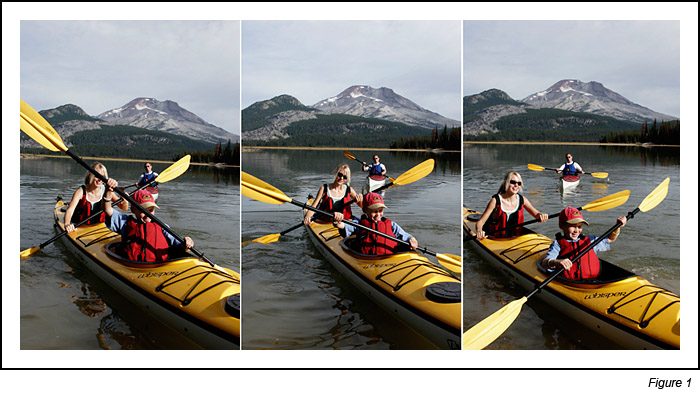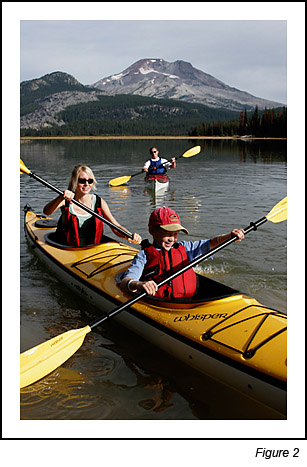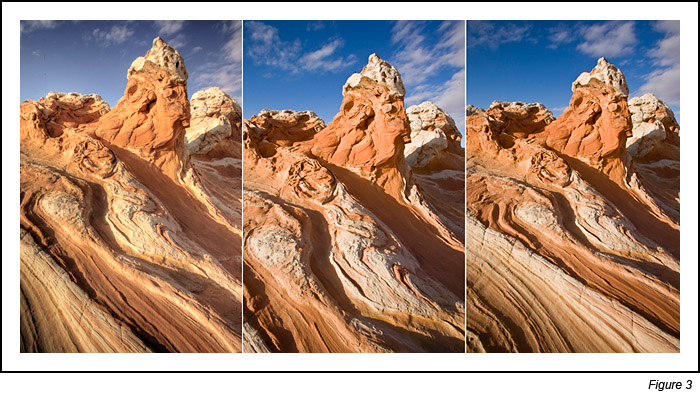Now that you plan to seek representation for your images, there are a few things to consider. The number one issue an agency will have is whether you know how to edit your images effectively and choose the best images or do you submit everything from every shoot. With digital photography, we tend to shoot many more images than we ever did with film and if you just send the whole shoot to the agent you will lose favor fast.
Agencies want photographers who understand their business and the stock business in general. They want you to make their life easier in the image submission process and it is clear that those photographers doing so will have their images uploaded and selling sooner. Photographers who earn the most fully understand how and what sells and adjust their shooting as such. Understanding Ďtheir businessí means you understand how to edit your submissions and only submit the best. Today, there is no room for any images that fit into the old adage; "Better keep it just in case". Instead it is "If in doubt, throw it out!" The nice part about shooting digitally is you can always have a change of mind, dig up the DVDís and reconsider images you originally rejected.
Once you return from a shoot and begin the edit, you will select the images you plan to keep and process. These images will make up a collection of what you believe will be the marketable images from your recent trip. Here you can keep and market whatever images you want as itís your choice. I have found that this editing process works best if done over several sessions. For example, I will make an initial edit and here I weed out the obvious weak images, technically flawed, and select the obvious keepers. I then come back later, maybe days, and do a second edit using the same criteria: what is the best shot! I will weed out even more and when I have selected the keepers, I then make one more pass to decide what I think my agent would like.
To determine which images are suitable for your agency you must take an even closer look at each image and again, make a determination as to what is the best of the best. I have found that if I have 20 or 40 variations of the same shot that the agent tends to take very few if any. This is the process they want the photographer to do, weed the shots down to just a few. When I have done this I find they tend to keep the few I have selected as the best images.
Here is one example of the editing process. This photo shoot was of a family out kayaking for the day at one of our nearby mountain lakes. I am standing in the water wearing hip boots and trying to capture them kayaking. The challenge was to get them in kayaking action without paddling by me to far for each series of photos, yet still be believable and it was much easier for them to move than it was for me.
The three examples below (Figure 1) show you several images taking during this photo shoot. You can see you can see that getting them in sync was a challenging. I had them paddle slowly to capture as many frames as I could, but as you can see on the left image, the young man in the front has his paddle right in front of his face as well as moms face behind him. Dad is also hidden in the background by moms paddle. In the center image there is better coordination with the paddles where the son has his at a nice angle while mom has hers in an opposite angle and dad has his yet again an opposite angle to mom. Here the paddles are hiding them a little bit too much. The image on the right appears to be more as if they're just sitting there posing even though they were paddling. It just happens I captured them with all the paddles in sort of a relaxed or nonmoving position.

Figure 2 shows the perfect shot. Here the paddles are much better position for each of the subjects where the son in the front kayak has his paddle leaning down the left while mom is the opposite direction. Dad in the back has his paddle the opposite direction of mom, a perfect position for all three boaters. Their faces are clear and not hidden by the paddles and nothing obstructs either of the kayaks.

Below (Figure3) is another photo shoot from Arizona's White pockets area. Here I photographed three different approaches to the same rock and wave formations in the sandstone. I essentially moved in closer with each of these different shots. Which one should I send to the agency? It's a tough decision because each of these are good shots and you do not know which one the stock photo agency will select.

However, I'm certain that the stock photo agency will only pick one image so I might as well choose my favorite, and in this case I would select to the center image with its stronger and more interesting foreground. No matter what you photograph, if you plan to submit the images to a stock photo agency you must be tough on yourself and on your images and select only the best image.
Submitting to Agencies
Now that you have searched through possibly thousands of images and culled it down to a few hundred for submission, whatís next? Once you have determined what their guidelines stipulate, then begin preparing your submission and organizing your best work. If they request between 200-500 images, pull your images and label them with professional labels (film) or accurate digital captions with proof sheets. Just like submitting to any client, make your submission professional looking remembering that a first impression goes a long way. Then send them off and wait to see what happens.
Pay to play?
One of the major marketing tools that agencies used for years to promote and sell images, was the catalog. These were small to large books containing images of every sort of categories in stock photography. They would have a large section of lifestyle and business, two top selling categories and also transportation, outdoor recreation, science, medical, and often a small section on nature. These catalogs costs plenty to produce and when they were first used, the agencies covered the costs as part of the photographer/agent relationship. The photographer pays to shoot images, the agency pays to promote and sell the work.
As time went on, the agencies decided that the photographer should begin to pay some of the cost of their image placement in the catalogs and the catalog fee was born. If your images were in a catalog there was a very good chance that you would make a lot of money off that placement so having your best work selected was a good thing. As time went on the agencies began to shift more of this burden to the photographer and it was no longer a 50-50 split. Some agencies even charged the full cost of catalog placement to the photographer forcing the photographer to bear the entire burden of catalog production.
This was unfair to the photographer whom at that time was receiving 50% of each sale. My agents charged $150 - $175 for a placement, or half the production costs. As commissions were dropping from 50% to 40% and even lower, the cost of catalog placement climbed. Agencies no longer produce the traditional catalog instead opting for the "magalog" approach which is a smaller direct mail, mini magazine/catalog. Here the costs of being placed in a magalog vary depending on the agency. I do not believe that getting into a "magalog" is all that advantages to photographers these days.
Many agencies at this time have several programs where photographers are charged for the placement of their images in higher profile venues. This should mean more clients see your photographs and you make more sales and it may be the case. Here again, these programs result in photographers having to pay more money to have their images seen by more people. Does this mean by paying the agency to join these programs the agency will put more effort into marketing your work? Be sure and explore what you are getting for what you are paying.
Volume
Stock photo agencies want volumes of images submitted to them from their photographers and they want them as often as possible. There are many full time stock photographers who keep them happy and when you inquire with an agency, they will ask how much you will plan to shoot. If you submit an occasional shoot once per year, do you think they will respond to your needs when asked to? The agency cannot grow and sustain the demands of the clientele for new and innovative work if they cannot motivate their photographers to create. This is a huge problem with every agency. They now are considering this even more when looking at signing on a new photographer. If they like your work, but know you have two jobs to sustain your photo habit, they can figure they wonít see a lot of work.
This has led to an interesting change within the industry: assignment stock photographers. Agencies are on a push to own their imagery and this means that there will be less room for freelance stock shooters in the big agencies. The trend is to hire great photographers and pay them very good day rates to go shoot the subjects they need. The photographer gives them the images and may receive commissions in the future for a short period or may never receive any. Since stock is so speculative, this appeals to photographers who do not have an interest in covering all the upfront costs on a shoot only to wait and see if anything sells.
Royalty Free CD Collections
6 out of 10 image sales are RF. If you are anti RF say goodbye to 60% of the market. With the advent of Royalty Free cdís in the late 90ís, the photo buying public rushed to buy these collections of images because they were free from all the heavy negotiating and usage renewal that came with traditional licensing. This was a good time to be shooting for any agency that jumped into the fray. Photographers shooting RF cd collections were later rewarded with substantial incomes in the form of royalties from these cd photo collections. Aggressive production photographers were reported making $10,000 per month in royalties or more.
Years later and with the internet stabilizing, the frenzy has slowed some as clients choose to buy single image downloads in lieu of an entire collection. There are still publishers out there producing RF cdís like Corbis and others. If you have an idea for a cd collection and have 100 stand alone images, you should contact a publisher and ask them to consider your idea. Remember, it has to be a common theme like skiing, etc.
Placing your images: RF or RM?
This is one of the toughest decisions photographers have to make. RM, or rights managed photography commands much higher prices than RF or royalty-free. It's a proven fact; rights managed sells much less than royalty-free. This brings up the old question: would you rather make one $1000 sale, or 1000 one dollar sales? Determining where your images should be placed depends on what you photograph. Are you photographing what everybody else is? My favorite example is Delicate Arch in Arches national Park, Utah. Everyone photographs Delicate Arch! This means charging big dollars as a rights managed photo is much more difficult because there are so many Delicate Arches in the market. On the other hand, if you have photographed lightning over South Dakotas Badlands, you have a rarer photo that can command higher prices. If you are uncertain about where to place your images just check with your photo editor at the agency and they will guide you as to where they think the images should be placed.
How many agents?
How many agents should a photographer be represented by? Too many agents can present problems! Having been with a total of 12 different agencies in my career, although no more than 4 at a time and some have done well and some have not. The good part about being with many agencies is that you have multiple revenue sources and hopefully money coming every month from each. The problem is that each agency has its strengths and weakness.
If you shoot something that is unusual and your agency jumps on it, you have to ask if they want it because they donít have it on file and need that subject. If that's the case then your work may not be represented well for a long time as they have not established a market for it yet. They may have accepted the work "just in case we get a request" for that subject. This, however, is more of a problem with smaller agencies than larger agencies.
You should investigate each agency before signing and see what they have on their website. Look for the subjects they appear strong at. If you are shooting pro sports and that is your specialty, I believe you will do better at an agency like Allsport. This goes for any specialty agency. If you imagery is exceptional wildlife, consider an agent that specializes in wildlife and all your general images with a general agency.
Next you need to decide if you can shoot enough material to keep the agencies happy if you sign with more than one. They are all content hungry and need photographers who crank out the volume. You need to be able to deliver once you sign the contract. With that said, we are in a time when representation by an agency is more difficult than ever and should one accept your work, you should jump at the chance.
Determination
Now that you have found a stock photo agency willing to represent your work, what do you plan to do next? How determined are you? The one thing they cannot provide is your determination and this can only come from you. If you decide to attend medical school next fall, or become a lawyer, you know that you are in for a long haul in learning those professions. Professional photography is no different and should be treated and approached the same way. You won't make much money if you're not determined and put the effort into creating highly salable images.
The longer you do this as a business the more it may become a job and so you must maintain a positive attitude to succeed. You may feel discouraged as the agency returns most of the images that you have submitted to them. You can, however, still sell the images the agency rejected. So the next step should be to go out and shoot and continue producing volumes of images.
Starting Out: Your strategy from here
Set your goals! Always be shooting, researching markets, and promoting yourself. Forget about your new stock photo agency for the next 12 to 24 months (with the exceptions of submitting regularly) and spend your money on building your image files. During this first two years your images may not sell very often as they need time to enter the market. If you have the urge to call your photo agency and find out if anything is selling, resist. Your photo agency will be much more impressed with you if you are continuing to submit images from new shoots and not concerned as to whether things are selling are not. The sales will come with time and the more images on the market, the more money.
During this period look for smaller markets that you can begin submitting other work for consideration such as the local postcard publisher. Research clients that you can shoot assignments for based on your current skill level. Create a brand and identity. Focus on your specialty. Keep shooting. Look for opportunities on the web. And the most important aspect: have fun!
Comments on NPN nature stock photography articles? Send them to the editor.
Charlie Borland has been a professional photographer for over 25 years. Based in Oregon, he shoots both locally and nationally, traveling extensively for a wide range of clients, some of which include: Xerox, NW Airlines, Fujitsu, Tektronix, Nike, Blue Cross, Nationsbank, Texas Instruments, Pacificorp, Cellular One, Early Winters, among others. He has received numerous awards and recognition for his photography.
Charlie has been heavily involved in the stock photography business, owning a stock photo agency for 8 years before merging with Definitive/FPG and later Getty Images. He is currently Director of Photography at www.fogstock.com an online agency he co-founded.
He also directs Aspen Photo Workshops where he conducts numerous workshops including: Making Money in Stock Photography, Travel Stock Photography, and several Adventure Sports and Cowboy Photo Shoots for stock photographers.